The Six Best Classic Gen 13 Story Lines of All Time
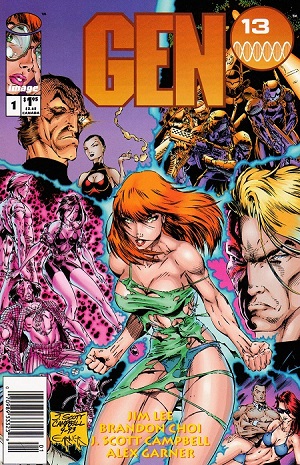
In many ways, Gen 13 is the quintessential 90's comic book. Brought to life by Image Comics superstars Jim Lee, Jeff Scott Campbell, and Brandon Choi, its artwork is unmistakable for the decade in which it's set. Beginning life as a riff on Marvel's X-Men, only with five empowered teenagers (three girls and two boys) under the tutelage of their older, wiser, and similarly-empowered mentor, it takes what was already an existentially angst-ridden background and cranks the woe-is-me dynamic way past eleven.
John Lynch, the team's Professor Xavier analog, defects from his position at International Operations when he can no longer stand to see the children used as test subjects with potential military applications. Fabulously wealthy from a lifetime of mercenary work and high-level employment at IO, Lynch pulls his five proteges out with him and they escape into the wilderness of...uh...California? This book is little more than "The X-Men" crossed with "MTV's Real World". Caitlin, Roxy, Bobby, Grunge, and Sarah are all from different walks of life, so naturally there's going to be conflict and drama stemming from that. Tossing Gen-Active (Image's code-name for 'Mutant') powers into the mix just makes things more interesting. It's no longer just fighting over forgetting to put the toilet seat down.
What differentiates Gen 13 from its Marvel roots (Jim Lee was famous, after all, for rebooting The X-Men a few years before he jumped ship to Image) is that Lynch does not foist the typical superhero responsibilities on them. The US government isn't interested in working with these rogue gen-active kids. There are no teams like The Avengers or The Fantastic Four to team up with. The city of La Jolla doesn't project a gigantic double-helix into the night sky to summon their assistance. If anything, Lynch would be content to lay low and out of IO's line of sight as long as possible. The kids are a team, but they're a team first and foremost to protect one another and help Lynch carry out his operations. Wolverine goes looking for trouble; Caitlin and Company only reveal themselves when trouble finds them.
The over-the-top powers, the bizarre villains, the fact Caitlin has a difficult time keeping her clothes in one piece, and the drama produced when these five kids all have to live under the same roof without killing one another...these are all part of Gen 13's long-running gag. It's thoroughly enmeshed in 90's culture and 90's 'Xtreme' sensibilities. If you weren't a kid or teenager at the time of Gen 13's publication, you're not likely to 'get' the comic. It plays heavy-handed with a lot of common genre tropes, makes fun of obvious pop culture references that are now twenty years out to pasture, and riffs on current events in both the real world and the comic book world that have long since passed their 'sell-by' date. Going back to it today is like watching a 45-year old prowl a college campus hoping to impress the ladies with his no-longer-impressive sense of fashion and pop culture minutia. Gen 13 is everything right, and thus everything wrong, with 90's comic books all wrapped up in one convenient package.
So why the hell do I love it so much?
Well, mainly for nostalgic purposes, I confess. I was the right age at the right time for Gen 13, and once I discovered it, I collected the ever-loving hell out of it. Most of the stories and one-shots aren't worth the cover price these days, but Gen 13 had a long, successful, and storied career with: a five-issue limited series; a seventy-seven issue unlimited series; a twenty-issue 'side story' series; innumerable crossovers with properties both inside and outside the Image universe; dozens of one-shots, annuals and other specials; and not one but two reboots, first in 2002 and then again in 2006, the latter of which ran for thirty-nine issues spanning a five year period. There was even a 90-minute animated film produced based on the original five-issue limited series, which you can view here if you want an introduction to the characters.
Gen 13 was enormous; outside of Spawn, it's the single-most prolific property produced by Image Comics. And while many of the stories are trope-ridden and clunky by today's standards, there's still some gold to be mined and enjoyment to be had even for those with only a passing familiarity of the comic. Here are my six choices for the best Gen 13 story arcs.
6) Grunge: The Movie (1996)
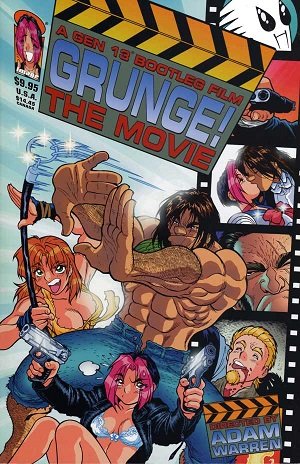
Remember the name Adam Warren, because it's going to come up on this list a lot. Famous for his manga-inspired artwork and renowned ear for dialog, Warren's irreverent attitude and pop culture knowledge combined to create some truly epic and hilarious situations for the Gen 13 kids to suffer through. Grunge: The Movie spanned issues 8, 9, and 10 of the Gen 13: Bootleg side-story series, but it was collected into the handy TPB pictured. If you can't find something to laugh about within this book's 80 pages of hilarity, then...well, I've never actually met someone with a pine cone wedged into their sphincter, but I can suggest a good physician.
Roxy and Grunge head to the mall for a date day involving one of Grunge's favorite hobbies: a martial arts multi-feature playing at the multiplex. Grabbing lunch between flicks, Grunge declares he could make the most kick-ass martial arts film of all time. Cue Roxy's disbelief. Cue Grunge's off-the-cuff extemporaneous explanation of how his film would go (a simple story of revenge by a lone survivor against the man who massacred his village), who the protagonists are (Grunge, naturally, takes the lead role), and how much gratuitous nudity would be featured (TONS!). What follows is a madcap romp through the annals of Hong Kong martial arts flicks as Grunge kicks, punches, and one-liners his way through his script, with none other than John Lynch himself playing the role of The Big Boss. With Roxy routinely busting in on the fantasy to complain when things get too sexist or absurd, and Grunge worrying over everything from product placement and guest stars (expect to see members of WildC.A.T.s, Team 7, and DV8 filling in as mooks for Grunge to dispatch at his leisure) to rip-offs homages to his favorite films and directors, one thing's for sure: you'll never look at Hot Wheels track the same way again!
5) Gen 13 Issues 13A/13B/13C (1996)
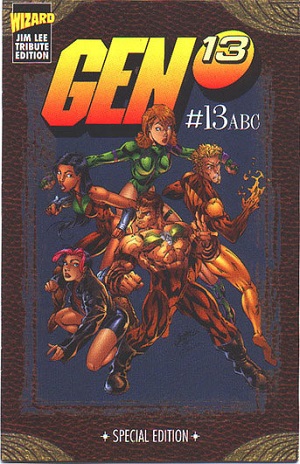
As if pulling the ultimate variant cover dick move wasn't enough, the boys at Image felt the need to celebrate the thirteenth issue of Gen 13's monthly run by creating three different issue 13s. Labeled A, B, and C, they fit together to tell a gloriously insane story of Grunge selling his soul for a premium chromium edition of his favorite comic (I told you this was a 90's book through and through). Surprisingly enough, Adam Warren isn't helming this madness--it's Brandon Choi all the way, but you could be forgiven if you didn't realize it. With cameos and appearances from pretty much everybody under the sun (guests include the Teenage Mutant Ninja Turtles; Bone; Spawn; Archie, Betty, and Veronica; The Incredible Hulk; Wonder Woman; Dark Horse's Madman; The Maxx; Hellboy; Wolverine; and Shi...and that's not even all of 'em!), the story's brain-warpingly insane, hilarious, and so 90's it'll hurt the soul of any modern-day collector.
Choi's story serves an important purpose though, and it's indirectly calling out the relationship comic book companies were cultivating with their fans: by hyper-inflating numbers, commercializing everything, and pumping out slipshod books the companies were doing buyers no favors. Conversely, by shamelessly buying everything a given company put out that was produced to cater specifically to them as consumers, comic fans were digging a grave for the companies they were supporting. This prescient call-out is even funnier today given the method(s) the story condemns were whole-heartedly embraced by Image themselves, who were as much to blame for the rise of the speculator bubble as anybody else, and who felt the explosion of that bubble bursting in their faces just as hard as everybody else did.
Of course, Image authorized Wizard to distribute a special "Jim Lee Tribute" edition of these three issues, collecting them all between two covers, because 'irony' wasn't a real word in 1996. Even if the story's too batshit insane for your tastes, it's worth the price of admission alone to see J. Scott Campbell drawing characters he'd never drawn before across multiple company lines. I can't imagine the legal headaches involved in wrangling together all the rights to use characters from so many different studios to make this book possible, but I'll forever admire Image's gumption in making it all work out anyway. There's a reason these guys were the golden boys of the era.
4) Superman/Gen 13 (2000)
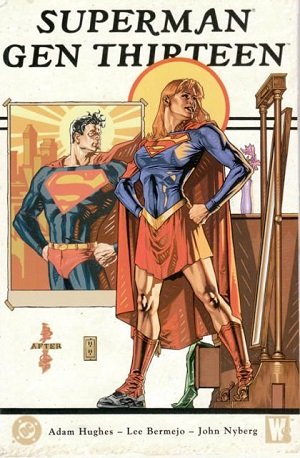
It's Caitlin's turn to pick the vacation destination, and she picks Metropolis due to her lifelong adoration for a certain superhero dedicated to fighting for truth, justice, and the American way. The rest of the team however does not share her interest, bemoaning Superman as a goody-goody, a boy scout, and too staggeringly upright and lame with his morals.
Going off on her own to get away from her mopey colleagues, a series of cranial collisions result in Caitlin acquiring amnesia. Given her basic invulnerability, a few mishaps with the local traffic combined with helpful hints from bystanders lead her to believe she's actually Supergirl who, for some reason, has temporarily lost her ability to fly. Despite this handicap, she goes around Metropolis attempting to right wrongs, but winds up causing even more trouble. This trouble attracts Lois Lane and Jimmy Olsen, who join the rest of the Gen 13 kids in the hunt for their friend, but it soon becomes clear there's only one man in Metropolis who has what it takes to get Caitlin the help she needs, and to save her from the wrath of the real Supergirl, who's livid some floozy is tarnishing her reputation.
Originally printed as a three-issue miniseries, Superman/Gen 13 was collected into the trade paperback as seen above. With art by Lee Bermejo and a script penned by cheesecake-drawing wunderkind Adam Hughes, this is easily the cream of the crop in the litany of "Gen 13 meets some other folks and hilarity ensues" books that rolled off the presses during the book's first run. The continuity nightmare introduced by having the gen-actives crossing into DC and Marvel universes seemingly at will makes hash of the companies' attempts at keeping New York separate from Metropolis and Gotham City, but if you ignore this and read it for the sometimes comical, sometimes heartwarming story it is, you'll not only come away with a deeper appreciation of Adam Hughes's scripting talents, but the Man of Steel himself. This had no right to be as good as it was.
3) Gen 13 Issue 67 (2001)
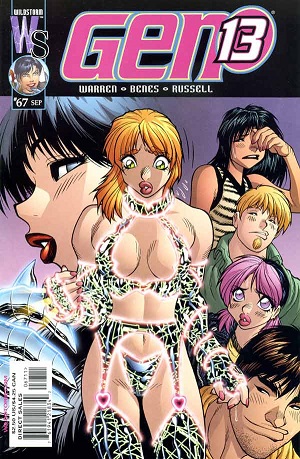
Remember when I said not to forget Adam Warren? Yeah, I wasn't joking. Warren was the final writer for the monthly book right up until its cancellation, and often provided the cover artwork as well, though he routinely left the pencils and inks to others. Issue 67 is part of a larger story arc entitled 'Meanwhile...' which was collected in its own TPB. Starting with issue 66, the arc gives one member of the team center stage per issue. In issue 67, it's Caitlin Fairchild's turn in the sun with a tale Warren entitles "Schrodinger's Wankerboy" for reasons that soon become obvious to readers (but that I'm not spoiling here).
Using some down-time to catch up on her favorite public radio science program, Caitlin is instead harassed by Ivana Baiul and enlisted to follow through on a promise she made to IO's leader in a previous issue as a way of repaying Ivana for restoring her Gen Active powers. IO, always on the hunt for new Gen Actives, has come across a promising subject. Normally the subjects manifest after some prodding by IO involving drugs slipped into the local water supply or other methods, but Joshua Morales spontaneously manifested his Gen Active ability very abruptly, even before IO could coerce it out of him. Since it's only prudent to use other Gen Actives to investigate newly-manifesting ones, and Caitlin is the closest Gen Active she can find, Ivana's cashing in her favor to use Caitlin as her point of contact.
Warren's script is as tight as Caitlin's Ed-Benes-penciled curves, and the story of Joshua Morales, his Gen Factor power, and the reason for its activation are heartbreaking in and of themselves, but the action Caitlin is forced to ultimately take is what stuck with me through the years hence. This is Warren at his best, combining popular science with popular culture, and layering on a healthy load of philosophy on top of everything. Hard to believe ten issues later the book would get cancelled, and there's a part of me that wonders if Warren would have poured so much of his creative energy into crafting a story like this if he knew the end was nigh.
2) Magical Drama Queen Roxy (1998)
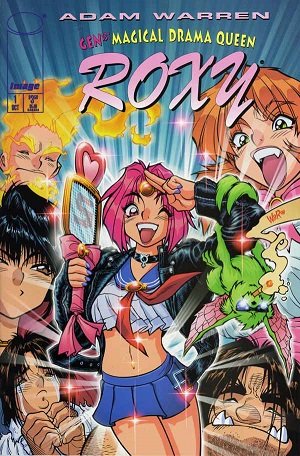
Adam Warren makes his third appearance on the list with this three-issue miniseries that focuses like a laser on Roxy Spaulding, and the result is the comic book equivalent of cutting open her brain so the readers can get a good look at everything making her tick. Every last one of her fears, her insecurities, her troubles, and yes, her drama, is peeled back for close inspection. The end result, while still told with Warren's flare for the absurd and comical, is the most deeply personal Freefall story of the entire series.
Warren pulls no punches with this script, which sees Roxy doing (metaphorical) battle with the rest of her team mates as she wrestles to come to terms with her place in the world. From her feelings of inadequacy where Caitlin is concerned to her seeming inability to connect with her boyfriend Grunge on more than the most superficial level, the reader is taken on a trip through the fragile organ that is the teenage female brain. While it's played for laughs, the wrap-up on the final page makes it clear this was far, far more than a simple parody taking jabs at the Magical Girl genre of anime (especially Sailor Moon, which was exploding in popularity in the US when this book came out), James Cameron's Titanic, Leonardo DiCaprio, and everything else a girl Roxy's age would have been enamored with at the time.
This one was never collected, so you'll need to track down the individual issues. Also, while I don't normally recommend picking up variant covers, this is one case where I'll make an exception: Tomoko Saito drew some beautiful alternate covers for issues 1 and 2, and Bubblegum Crisis fans will no doubt want to get their hands on Kenichi Sonoda's variant for issue 3. If Freefall isn't your favorite Gen 13 character when you start reading, I guarantee she will be by the time you finish.
1) Ordinary Heroes (1996)
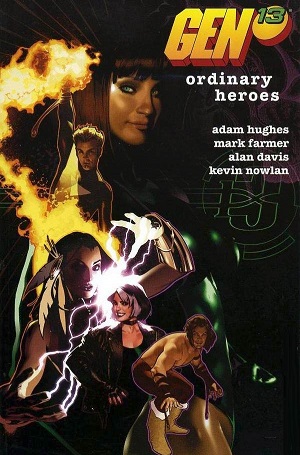
Adam Hughes both wrote and drew this two-issue miniseries, and the result is, hands down, not only the greatest Gen 13 story ever told, but one of the best comic book stories ever told, period. Opening with an iconic image of Caitlin, Bobby, and Rainmaker standing in the ruins of a burnt-out city while Roxy cries over Grunge's fallen body, and Caitlin's musing that she can't believe he's dead after all they went through, Hughes flashes back twenty-four hours to show what led up to the scene. Caitlin is picked up by Lynch and told to suit up, but refused further information or instructions as she and the rest of the team are transported to their unknown destination. This leads to grumbles among the team, with all of them naturally irritated that Lynch is treating them like children instead of team mates.
Upon reaching their destination, the group is attacked by mechanized fighters employed by IO, and their ship is torn apart. The five teens fall, but none of them sees Lynch eject. They turn the tables on their attackers only to come face to face with the target IO is trying to quarantine: a giant, globular biomass that gets bigger and bigger the more it devours. It's escaped from an International Operations laboratory, and the group is having little success in their battle. When the horrifying truth about the organism comes out, and Lynch's backup plan for containing it goes up in flames, it's up to Caitlin to guide the team to a solution--failure to do so, and quick, will result in not only their deaths but the immediate sterilization of the area and the loss of tens of thousands of civilian lives as well. Ultimately it's Grunge who comes up with a plan to beat the creature, but the end result will be catastrophic in ways none of them could predict.
If you aren't in tears by the end of Ordinary Heroes, then you have a heart made of solid granite. Adam Hughes lays on the pathos in this Kobayashi Maru scenario where there's literally no way to win, and the results force every member of the team to think about just what it means to be heroes. When I say Gen 13 isn't a superhero book, it's because superheroes are rarely tasked with growing up this fast and making these kinds of life-or-death decisions and sacrifices at such a young age. Rainmaker gets a beautiful opportunity to serve as the group's conscience here, and Hughes plays it for all its worth--she's not just addressing her team mates, she's addressing the reader as well. One cannot read Ordinary Heroes and remain unchanged. It's that damn good.
But what about you, true believers and lifelong fans? Did you read Gen 13 growing up? Do you have a favorite storyline or plot I failed to mention here? I could have easily done a Top 10, so I know there are other story arcs out there worthy of inclusion. Tell me yours in the comments below, and whether you agree with my selections or not. I can't wait to see what you all come up with!
I like the Drama Queen Cover 😊 @peekbit
And 400+ up votes... unbelievable. I'm happy to see it 😊 You really deserve it and of course your post too.
Magical Drama Queen Roxy had the best covers of the whole series. :)
Also: I woke up today and saw all those upvotes. Holy cow...I have no idea how this happened, but I'm not complaining in the least. Thanks so much, @peekbit! :)
Oh 😊 thank you @modernzorker for posting the other covers... I really like the Japanese touch.
They have nice fashion in Japan - chic, crazy and sexy all together... maybe fancy is a good word for this unique combination.
The girls in the cover are looking sexy but not 'cheap' at all. If I would live in Japan... 💭 ☺️
And anyway - the drawing is nice.
sexy covers 👍🏼
Not gonna lie, they're some of my favorite in my collection. :)
thank you for sharing them 👍🏼
To listen to the audio version of this article click on the play image.

Brought to you by @tts. If you find it useful please consider upvote this reply.
Holy cow, this is really cool! I didn't know there was a group converting articles to audio versions for the visually-impaired. I love it, and I'm flattered you thought this was worth the time to convert. Thanks, @tts!
I've seen some of it but never really became a fan even with Jim Lee being part of it.
That's totally understandable. It's a comic that, on the whole, was relevant precisely during its run and never will be again barring some temporal distortion that throws us back in time twenty-five years. I don't hold not being a fan against anyone, and I'm glad you took the time to check it out, @artgirl! Thanks so much. ^_^
Cool. Love your post. :)
Lots of good information, reminds me of my comic reading days, back then mostly Marvel and DC.